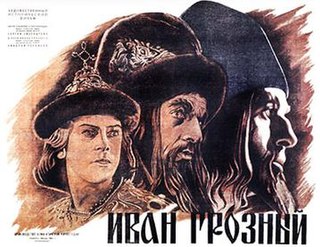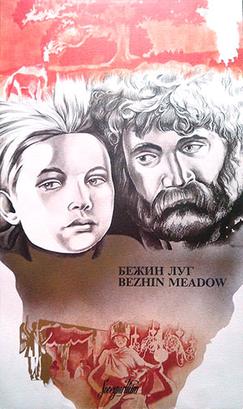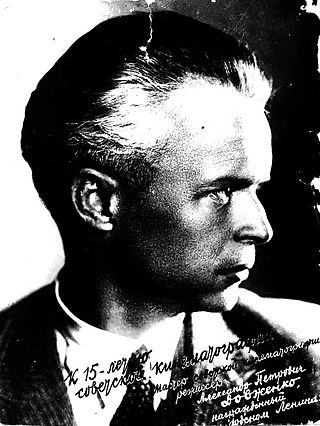Related Research Articles

Sergei Mikhailovich Eisenstein was a Soviet film director, screenwriter, film editor and film theorist. He was a pioneer in the theory and practice of montage. He is noted in particular for his silent films Strike (1925), Battleship Potemkin (1925) and October (1928), as well as the historical epics Alexander Nevsky (1938) and Ivan the Terrible. In its 2012 decennial poll, the magazine Sight & Sound named his Battleship Potemkin the 11th-greatest film of all time.

Snow White and the Seven Dwarfs is a 1937 American animated musical fantasy film produced by Walt Disney Productions and released by RKO Radio Pictures. Based on the 1812 German fairy tale by the Brothers Grimm, it is the first full-length traditionally animated feature film and the first Disney animated feature film. The story was adapted by storyboard artists Dorothy Ann Blank, Richard Creedon, Merrill De Maris, Otto Englander, Earl Hurd, Dick Rickard, Ted Sears and Webb Smith. David Hand was the supervising director, while William Cottrell, Wilfred Jackson, Larry Morey, Perce Pearce, and Ben Sharpsteen directed the film's individual sequences.

Battleship Potemkin, sometimes rendered as Battleship Potyomkin, is a 1925 Soviet silent drama film produced by Mosfilm. Directed and co-written by Sergei Eisenstein, it presents a dramatization of the mutiny that occurred in 1905 when the crew of the Russian battleship Potemkin rebelled against its officers.

The Gerasimov Institute of Cinematography, a.k.a. VGIK, is a film school in Moscow, Russia.

A Bronx Morning is a 1931 American Pre-Code avant-garde film by American filmmaker Jay Leyda (1910–1988).

Ivan the Terrible is a two-part Soviet epic historical drama film written and directed by Sergei Eisenstein. A biopic of Ivan IV of Russia, it was Eisenstein's final film, commissioned by Soviet Premier Joseph Stalin, who admired and identified with Ivan.
Montage is a film editing technique in which a series of short shots are sequenced to condense space, time, and information.

Strike is a 1925 Soviet silent drama film directed and edited by Sergei Eisenstein. Originating as one entry out of a proposed seven-part series titled "Towards Dictatorship of the Proletariat", Strike was a joint collaboration between the Proletcult Theatre and the film studio Goskino. As Eisenstein's first full-length feature film, it marked his transition from theatre to cinema, and his next film Battleship Potemkin emerged from the same film cycle.
Edmund Meisel was an Austrian-born composer. He wrote the score to Walter Ruttmann's Berlin: Symphony of a Metropolis (1927), The Battleship Potemkin (1925), and other films of Sergei Eisenstein. Meisel was one of the more important and pioneering figures in film music. Much of his work and the evidence of his significance was lost for more than fifty years.

Soviet montage theory is an approach to understanding and creating cinema that relies heavily upon editing. It is the principal contribution of Soviet film theorists to global cinema, and brought formalism to bear on filmmaking.
Jay Leyda was an American avant-garde filmmaker and film historian, noted for his work on U.S, Soviet, and Chinese cinema, as well as his documentary compilations on the day-to-day lives of Herman Melville and Emily Dickinson.

The General Line, also known as Old and New, is a 1929 Soviet drama film directed by Sergei Eisenstein and Grigori Aleksandrov.

Bezhin Meadow is a 1937 Soviet propaganda film, famous for having been suppressed and believed destroyed before its completion. Directed by Sergei Eisenstein, it tells the story of a young farm boy whose father attempts to betray the government for political reasons by sabotaging the year's harvest and the son's efforts to stop his own father to protect the Soviet state, culminating in the boy's murder and a social uprising. The film draws its title from a story by Ivan Turgenev, but is based on the life of Pavlik Morozov, a young Russian boy who became a political martyr following his death in 1932, after he denounced his father to Soviet government authorities and subsequently died at the hands of his family. Pavlik Morozov was immortalized in school programs, poetry, music, and film.

The Parvo was a 35mm motion picture camera developed in France by André Debrie. The patent was registered in 1908 by his father, Joseph Dules Debrie. The camera was relatively compact for its time. It was hand-cranked, as were its predecessors. To aid the camera operator in cranking at the correct speed, the camera had a built in tachometer.

¡Que viva México! is a film project begun in 1930 by the Russian avant-garde director Sergei Eisenstein (1898–1948) under contract to socialist author Upton Sinclair and other supporters in the United States. It would have been an episodic portrayal of Mexican culture and politics from pre-Conquest civilization to the Mexican Revolution. Production was beset by difficulties and was eventually abandoned. Jay Leyda and Zina Voynow call it Eisentein's "greatest film plan and his greatest personal tragedy".

Oleksandr Petrovych Dovzhenko or Alexander Petrovich Dovzhenko, was a Ukrainian Soviet screenwriter, film producer and director. He is often cited as one of the most important early Soviet filmmakers, alongside Sergei Eisenstein, Dziga Vertov, and Vsevolod Pudovkin, as well as being a pioneer of Soviet montage theory.
A list of books and essays by or about Sergei Eisenstein:
Annette Michelson was an American art and film critic and writer. Her work contributed to the fields of cinema studies and the avant-garde in visual culture.
References
- ↑ Eisenstein, Sergei (4 April 1986). Eisenstein on Disney. Seagull Books. ISBN 9780930621384 – via Google Books.
- ↑ Eisenstein, Sergei; Leyda, Jay; Upchurch, Alan Y (4 April 1986). Eisenstein on Disney. Seagull Books. OCLC 16529071 – via Open WorldCat.
- ↑ "On Disney".
- ↑ "ON DISNEY by Sergei Eisenstein".
- ↑ "Stalin, Walt Disney, Eisenstein, & Ivan the Terrible". Cliomuse.com.